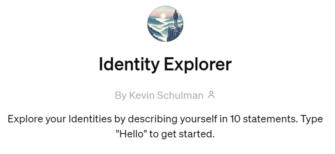Who Are You?
The Twenty Statements Test (TST) was created by two social psychologists in the 50s’. Maybe I’m waxing nostalgic but give me the days of low creativity, high literal simplicity in my assessments.
The test is nothing more than completing this sentence, “I’m a __________.” 19 times. Kidding, 20, times, c’mon.
It’s an interesting self-reflective exercise that adds some living color to the Identity topic. The responses can be self-coded into Identity categories or these days, by generative AI.
So, we did just that by building a version of the TST, Identity Explorer, that you can take (anonymously and free) in 3 minutes or less. You can find it here.
We added our own categorization rubric to automatically group Identities into,
- Individual Identity: Traits, characteristics, and states that are intrinsic to you and distinguish you as unique. Examples include personality traits and physical descriptors.
- Relational Identity: Identities formed through your relationship to others, describing roles that define you in a social or familial context.
- Social Identity: Identities related to larger groups or communities, such as national, racial, occupational, or recreational groups you feel part of.
Here’s my results,
Your Identity Responses Categorized:
- Individual: Runner, Low in Agreeableness, Entrepreneur
- Relational: Husband, Father
- Social: Social Scientist, Virginian, Dog person, Sports fan, Skier
Tabular Summary:
Identity Category |
Proportion |
Examples |
|---|---|---|
Individual |
30% |
Skier, Runner |
Relational |
20% |
Husband, Father |
Social |
50% |
Social Scientist, Virginian |
Here’s three reasons to give it a whirl. You can find it here.
- It’s a good way to illustrate Identity to yourself and others by making it personal.
- The Identity categorization is a useful way to think about how you can create connection with your donors.
- It’s a primer on building custom GPTs. This took 90 minutes and it’s a no code, user-friendly way to customize and tailor GPT to do specific, tailored tasks.
The caveat emptor is this,
- It’s not an ideal way to figure out the relevant Identities on your donor file.
- First off, the exercise suffers from primacy bias, first answers are usually the most salient.
- The bigger failing is that an identity is activated by context.
- In a vacuum the first few (or all 10) might be the most important to you but they don’t necessarily include the Identity that is most germane when giving to charity A, B, C or X, Y, Z.
- I didn’t list “conservationist” in my ten but if I saw advertising from TNC then that’s the Identity of mine that would be activated to help make my give/not give decision.
Kevin


